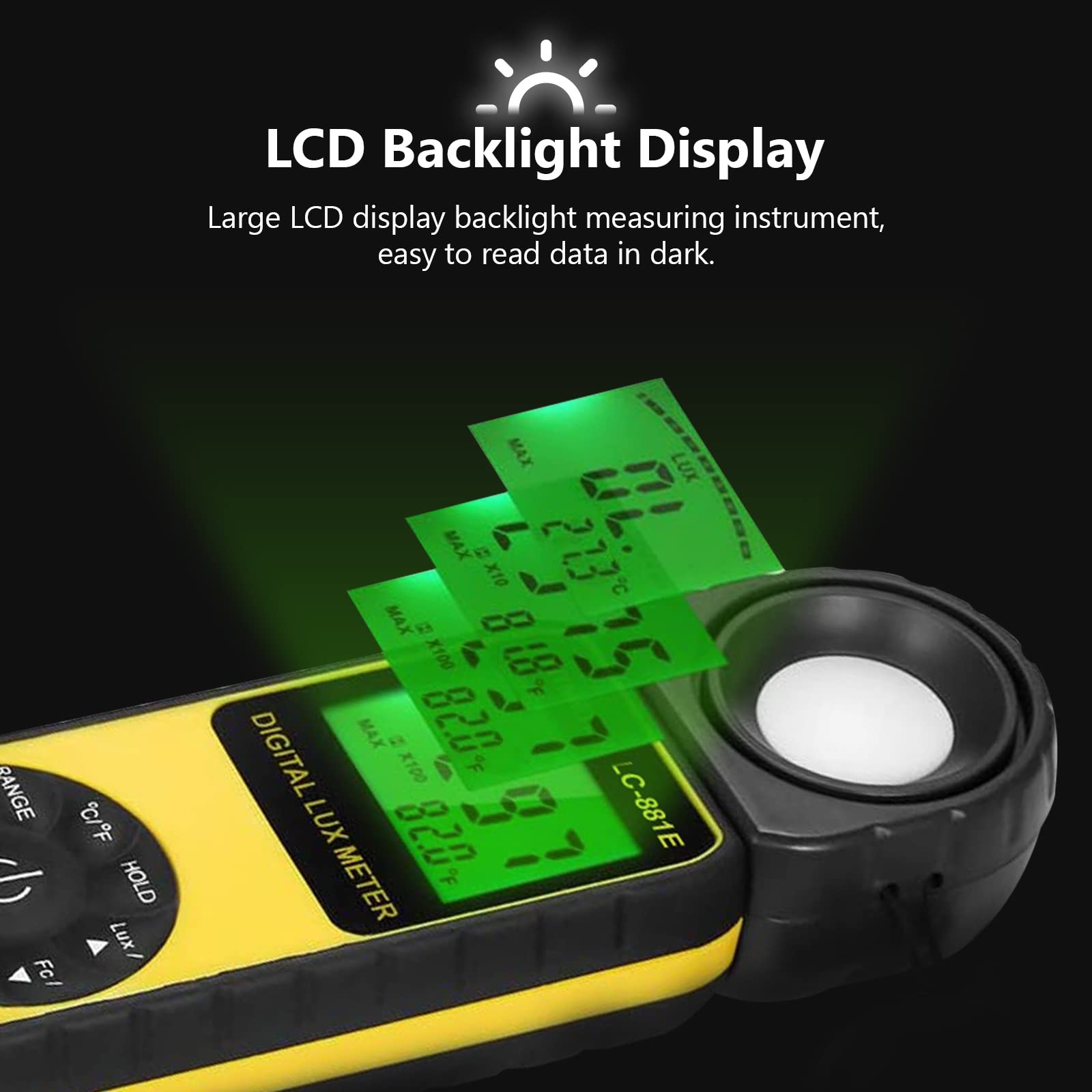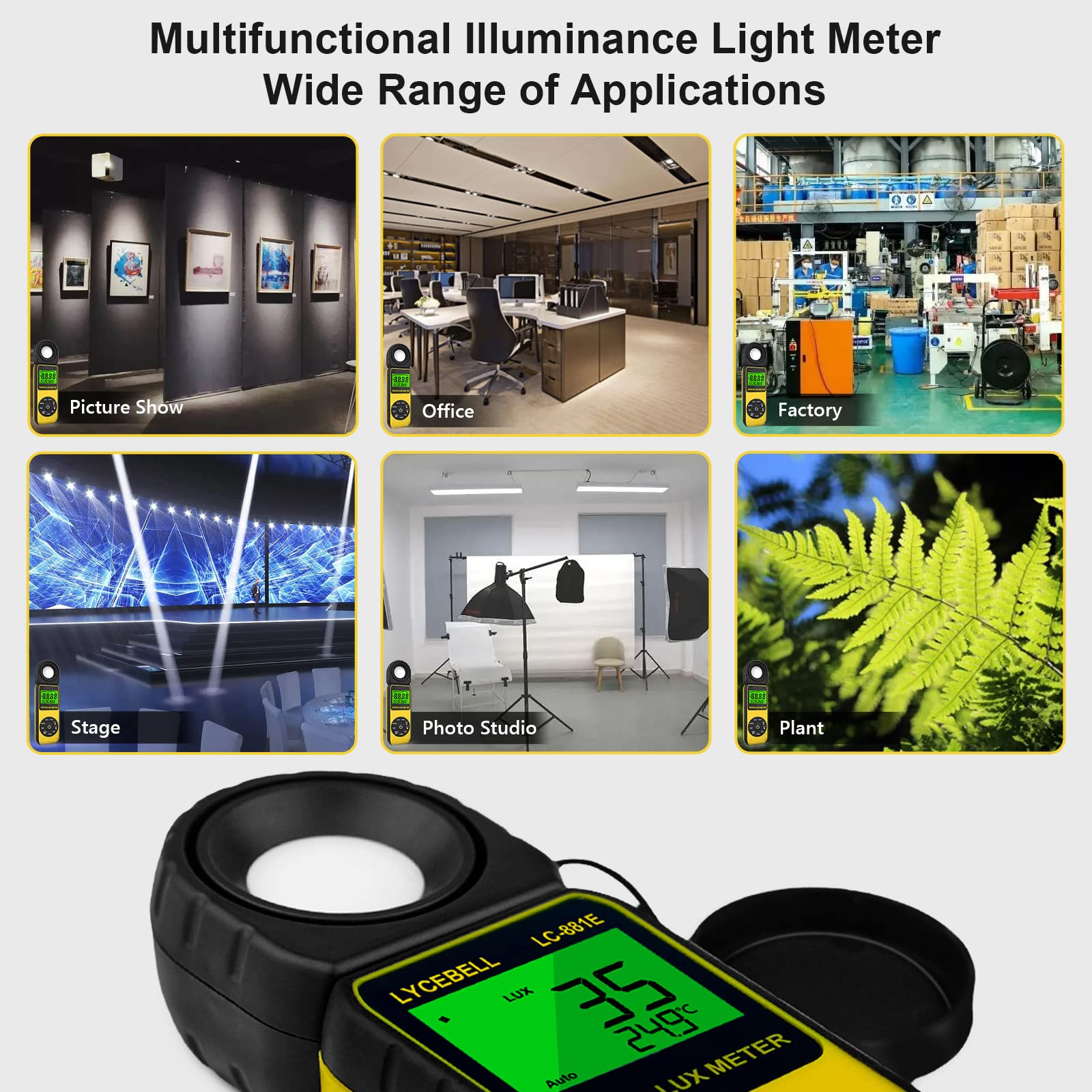Customer Services
Copyright © 2025 Desertcart Holdings Limited
Desert Online General Trading LLC
Dubai, United Arab Emirates








🌟 Light Up Your Measurements with Precision!
The Light Meter LYCEBELL LC-881E is a high-precision digital illuminance meter designed for a wide range of applications, featuring a measurement range of up to 300,000 Lux, a backlit LCD display for easy reading, and a 270º rotatable detector for versatile use. Ideal for professionals in photography, horticulture, and various industries, this meter combines accuracy with user-friendly design.
A**R
Best price among identical devices
You might notice that this device is identical to several others except for the brand sticker. So I chose the least expensive. It works just great — no issues at all, and seems perfectly accurate based on a comparison with my friend's meter. (Light readings change so much with just a tiny shift that it's hard to get a static reading.)For me it's a perfect device for checking the amount of light hitting my plants. There are a zillion guide that specify foot-candles of light a plant needs, although some of them use lux or even lumens instead. This little guy does all three and the instructions are simple even I could figure them out.It feels solid enough, but it's not like I'm taking it into combat. I like that the cap has a string attaching it, so no worry about losing it. Honestly, what else to say? It works, it's easy to use, and it's the least expensive of several identical devices. Go for it.
J**Y
Good value
Have had for three months. Works well.
J**S
Impressive
I’m genuinely impressed with how well it works and how cheap it was. It definitely FEELS cheap and is made out of very cheap plastic BUT it works incredibly well and is very accurate so I guess it’s great because if I break it I won’t care lol and if I’m on site and 20 feet in the air checking lamps I might just drop it like my last one but this time it won’t matter lol. Worth the money for sure
P**S
It works
I never realized the degree of difference little alterations make. Worth the money.
H**N
This will not correctly measure light for a led hydroponic light!
This is not a bad LUX meter if that is what you are buying it for. The description is off though when it says LED testing. It does not test the spectrums that will burn your plants. It's not meant to gauge the distance of how high to hang your LED lights. So if you're purchasing this for that purpose I recommend a PAR meter and not this!
P**S
Convenient low-end light meter with no usable data on its spectral sensitivity
This meter is working well for me to compare the relative brightness of my video lights, and how much light I lose when I put them in light modifiers like a soft box. I can also now track the performance of my LEDs and keep track of whether they are getting dimmer with age.Tripod mounting socket is nice for repeat measurements comparing the brightness of different lights.Although it isn't a photographic light meter that would give you exposure information in ISO, aperture and shutter speed, it can tell you the light ratios of your key light and fill light, and help you adjust your lights for even illumination.One thing I noticed with the meter is that the bi-color LED lights I have always give a lower reading when set to 3200K than 5600K, but I don't know if this is because the lights are actually dimmer at 3200K or if the meter is just less sensitive. The instructions come with a crudely reproduced sensitivity graph, but there are no numbers on it, making the graph utterly useless.Another issue is that the meter is not auto ranging, you have to manually set it to different ranges. Not a huge deal, but auto range should be an option.I've been able to put the meter to good use and I'm happy to have it.Note that this is a generic meter that is sold under many different brands. Also note that the same case is used for different models, so this meter might look identical to another but could have different specifications and features. 4 stars means I would buy one again if the price was right.
T**R
Easy to Use, Reasonably Accurate
The media could not be loaded. This meter is small and easy to use, which is good because the included instructions are minimal. The auto-ranging function is handy, and the pivoting sensor-head is novel. The included case is sufficient for protecting the meter from scratches, but it is clearly not designed for impact-resistance. Batteries and a small screwdriver to install the batteries are also included.This is not a Professional quality (“Precision Class”) meter and so should not be used to validate compliance with minimum illumination specifications (for example, Emergency Lighting requirements inside a commercial building). For general-purpose use, however, this meter is fine and it appears to be comparable in performance to other General-Class lux meters. This meter would be effective, for example, for comparing lux measurements in different locations within the same conference room, or within a retail display-space, in order to check for uniform illumination.The included specifications / Instructions sheet includes a Spectral Sensitivity graph, which would normally indicate how well the meter evaluates perceived brightness, as compared to the CIE Spectral Luminous Efficiency Function. Because some colors appear brighter to the human eye than others (for example green wavelengths appear significantly brighter than red wavelengths), Lux measurements are affected by the actual wavelengths of light present in artificial lighting, which is not truly white-light (be those incandescent, fluorescent, or LED light sources). When the meter matches closely to the CIE function, more accurate Lux measurements are obtained. The included graph for this meter, however, is poorly reproduced and shown without any indication of wavelengths, making it basically useless as an indication of measurement quality.So, I took a few test measurements with the meter and found the values to be within expected ranges. For example, I placed the meter on the back patio in full afternoon sun and pivoted the sensor so that it faced into the sun – Measured Value: 65,700 Lux; the typical range for full sun (see attached reference table photo) is between 32,000 and 100,000 Lux. I also placed the meter on our kitchen island, directly below one of the can-light fixtures (7 feet above the countertop); the bulb in the can fixture was a 20W LED Par38 bulb, rated at 1300 Lumen – Measured Value: 540 Lux; a typical value for kitchen task-lighting is ~500 Lux. Based on these and a few other measurements, I found the meter to provide reasonable results.
T**’
Not sure on this one…
So these things are always hard to test if you don’t have a control or another known meter you can check against…With that being said this unit is made pretty nicely. Feels good in the hand comes with a case which is always a plus.Results were about the same in control situations however I did have one or two pretty far off readings… Might be worth a look.
A**R
Excellent
Prise de Température d’un poulailler
Trustpilot
1 month ago
2 weeks ago